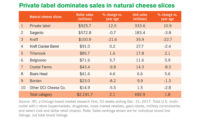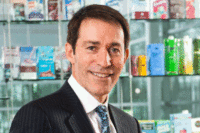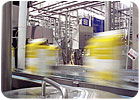
Milk and other fluid products at Denver are filled with a 26-head Federal filler and two Evergreen carton fillers.
DENVER-On its surface, the Safeway Inc., milk plant in Denver is not so different from most milk plants. It does a mixture of milk and other beverages on one rotary filler and two carton fillers. Like most dairy plants it has a HACCP plan, and since 2001, it has a beefed-up set of plant security SOPs. It operates under stringent local and federal regulations and is maintained to an extremely high degree of sanitation. Raw milk and other ingredients come in and bottled milk, beverages and cottage cheese go out.
But when it comes to making those somewhat ordinary products at a consistently high level of quality-and making those quality products efficiently and cost effectively-the Denver plant is head and shoulders above the competition as surely as it is a mile above sea level.
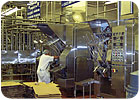
Milk and other fluid products at Denver are filled with a 26-head Federal filler and two Evergreen carton fillers.
"You can see the progression here," says Plant Mgr. Jay Marshall, as he points to the plaques he has laid out in his office. Duplicates are given prominent space in a common area of the plant, and the achievements are noted right outside the main entrance to the building. "This plant has been getting better and better for the last four years."
The competition for these awards takes place among 33 separate Safeway manufacturing facilities in North America. This includes nine milk plants, four ice cream facilities, eight bakeries and four carbonated beverage plants.
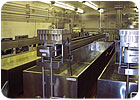
The cheese room includes four 5,100 gal Stoelting vats and an automatic curd forming system.
What makes the plant successful?
Marshall and other managers say it's a teamwork system that empowers everyone involved to find new paths to overcoming obstacles. Of course that only works when there is a buy-in from the employees on the production floor."I would say that the vast majority of the employees here are totally dedicated and really want to do well," says Supervisor George Brown, Jr.
One of six Safeway milk plants in the United States, the Denver plant was built in 1966, and has served as a bottling plant for all of its 40 years. At various times, its warehouse has been used to commingle other products for Safeway.
The facility is strategically located along Colorado's main east-west thoroughfare, Interstate 70, on the east side of Denver. The plant totals 96,000 sq ft, and is situated in a campus with a Safeway bakery and a frozen food warehouse. Across the street from these is a beverage plant, a meat warehouse, a variety (mostly consumer goods) warehouse, and a produce warehouse. The milk plant itself employs a staff of 70 and product lines include milk, juice, drinks, and water, eggnog, and cottage cheese. There are three bottling lines and two cottage cheese fillers.
"We supply milk for Denver, much of Colorado and some of the surrounding western area," Marshall says. "Cottage cheese goes to a much wider area."
Some co-packing is done, but the majority of the production goes into fulfilling Safeway's needs. Most products carry Safeway's Lucerne brand.
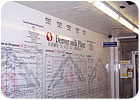
The plant uses a wall chart in an all-access area of the plant to identify, track, and solve any kind of obstacle or problem on the production floor. At the top are the plaques recognizing Denver's performance over the last three years.
Interdepartmental effort
As Marshall ledDairy Foodsthrough the plant recently, one of the first stops was a hallway leading to the various production areas. Most companies have some sort of motivational messages and information in this kind of area-the idea being to get employees in the right mindset as they begin a shift. The messages and information at the Denver plant, however, have a bit more substance than most."This is how we track any kind of problem that anyone finds out on the floor," Marshall says, gesturing to a massive message board grid. "We find that this really helps us get things fixed a lot more quickly."
On a nearby window are some photos and a written report explaining the results of a recent cross-departmental maintenance session.
"Once a month we do a special maintenance shift on a given piece of equipment or work station where everyone who is involved in the production that takes place in that area gets involved with breaking down that machine," Marshall says. "It really gives you an opportunity to get everyone's perspective on how things can be done better."
These efforts are part of a business and production strategy that the Denver plant and all other Safeway plants have adopted. It's a cornerstone tool that allows Safeway plants to reach peak performance. One facet of it is the "the Five S's" which are also posted in the common area:
- Sort
- Shine
- Standardize
- Store
- Sustain
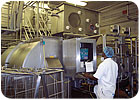
An operator monitors production in the cheese room. All employees are engaged in a teamwork strategy designed to enhance overall performance.
"The thing that makes our plant so successful is the approach of upper management. It's really about providing guidance," Harmon said. "It's not about looking for mistakes, it's looking for what can be learned from mistakes."
The criteria for the award program includes things like cost management, product quality, employee safety and so on.
"We get graded on things like adherence to our World Class Manufacturing principals and our production strategy," Marshall says. "We are audited, and they really make sure that we are doing what we are supposed to be doing."

Recent equipment upgrades include two cheese fillers from Modern Packaging.
Big (cottage) cheese
Safeway Inc. is one of the largest supermarket chains in North America, and the Denver plant plays an important role among the 17 dairy plants owned by Safeway."Our sister plant in Bellvue (Wash.) also does cottage cheese, so when necessary, we coordinate our cottage cheese production with them," Marshall says. (In fact, Bill Schoenbachler, who served as plant mgr. and superintendent in Denver for many years, recently transferred to Bellvue.) Last year, Bellvue was shut down temporarily for retooling and Denver had to pick up the extra cheese volume.
"For a couple of weeks we were most likely making more cottage cheese than any other plant in the country," Marshall says, while walking through a cheese filling room that was upgraded just a few years ago.
Even with Bellvue up and running, the Denver facility makes a lot of cheese-about 400,000 lbs per week to be more precise.
"We start in the evening and set vats and then we do most of the filling in the morning. We run five days a week."
Pasteurized milk is brought from storage silos and pumped into one of four, 5,100 gal Stoelting vats. Once the curd is set, it is knifed and pumped to a draining and salting unit and finally blended with cream.
The plant produces fruit-blended cheese using fruit shipped in aseptic tanks. Those products are blended in one of two 11,000 lb mixers.
The cheese is packaged on two Modern Packaging machines. A four-lane machine is used for small sizes ranging from 8 oz to 2 lb cups. The second machine is set up for larger formats of 3, 4, and 5 lb tubs. Once the cups are finished they are sent to a Delkor Spot-Pak machine for secondary packaging. Tubs are put in milk crates.
Cheese, like all products, is evaluated and tested in the plant's full-service lab.

Recent equipment upgrades include, since July, an automated Cannon case washer.
Milk and beverages
Raw milk is delivered to an enclosed 3-bay receiving area. Mixproof valves allow one truck to be washed while others are discharging milk.Incoming loads must be sealed and all incoming milk is tested for antibiotic residue, fat content, water, and somatic cell counts. On average 18-20 tanks are received each night.
The plant has five raw milk tanks that hold a total of about 320,000 gals.
There are two HTST process rooms that use batch standardization. Unit one uses a tube heat exchanger, but within the coming months, it will be refitted with a 7-section heat exchanger to match unit two. This will allow the plant do all of its production on either system.
A blowmold operation includes two 6-head Uniloy units and there is still room to double the capacity. A bagging unit allows the plant to keep at least a full day's worth of jugs on hand should there be any failures in the blowmold operation.
The blowmolders can also be linked directly to an alpine accumulator and fed overhead to the filling room.
A 26-head federal filler is used for gallons. Products filled here include all fat levels of milk, drinking water, orange juice, and Tampico.
Water is treated with a charcoal filtration and R/O system.
An Evergreen H-90 is used to fill half gal gabletops and a Q-11 for quarts and pints. Product lines here include all levels of milk, half and half, and whipping cream. Once the fluid products are filled, the packages are conveyed to refrigerated staging and loadout.
The plant produces more than 450,000 gals of milk and 60,000 gals of other beverages a week.
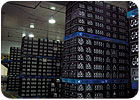
Products are loaded into 6-gal milk crates before being dispatched to a Safeway distribution facility across the street.
Storage, loadout and physical plant
Ingredients, packaging and other supplies are stored in a 10,000 sq ft dry storage area. Beverages and large format cottage cheese tubs go into milk crates. For gallons, Denver uses a 6-gal crate.Crates are auto-palletized, and pallets are stacked directly on the floor and orders are picked with conventional forklifts with on-board WMS. Once orders are staged they are loaded out by drivers through one of 15 loadout doors. Product is taken to a nearby Safeway distribution center.
Milk products are delivered to nearly 150 stores in Safeway's Colorado region, while cottage cheese is distributed to 1,800 locations in 10 states.
Returning crates are washed and sanitized with a Cannon case washer installed in July. The plant utilizes Cannon case handling equipment as well.
The Denver plant staff also prides itself in being efficient in terms of utilities and in having a clean, secure facility. A new lighting system will be installed in coming months to reduce electrical use and emissions. In 2004 the plant worked with Orkin Pest Control to implement a more stringent pest control system that offered better communication and accountability. Denver's current plant security systems and procedures include formidable perimeter fences and gates, secured parking and docking, and key card access that limits access for all sections of the plant to those employees who are authorized for access.
PLANT FACTS
Built: 1966Square Feet: 96,000
Lines: Five
Products: Milk, Beverages, Cottage Cheese
Employees: 70
Sidebar: SAFEWAY, DENVER VENDORS
Berry PlasticsCanon Equipment
Delkor Systems
Evergreen
Federal Filler
Forbes
Kerry Biosciences
Modern Packaging
Pacific Fruit
Portola Packaging
Stoelting
Tampico
